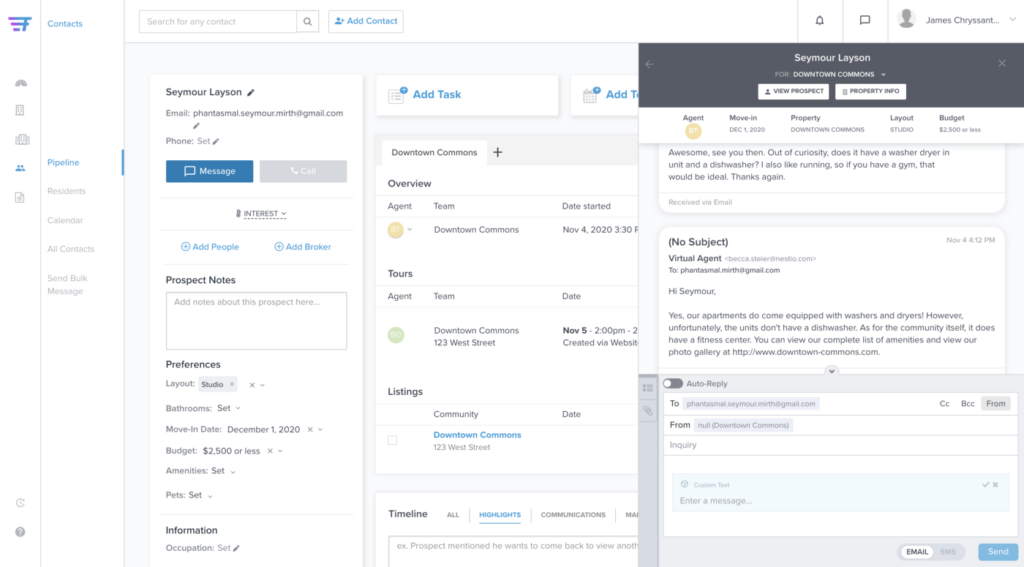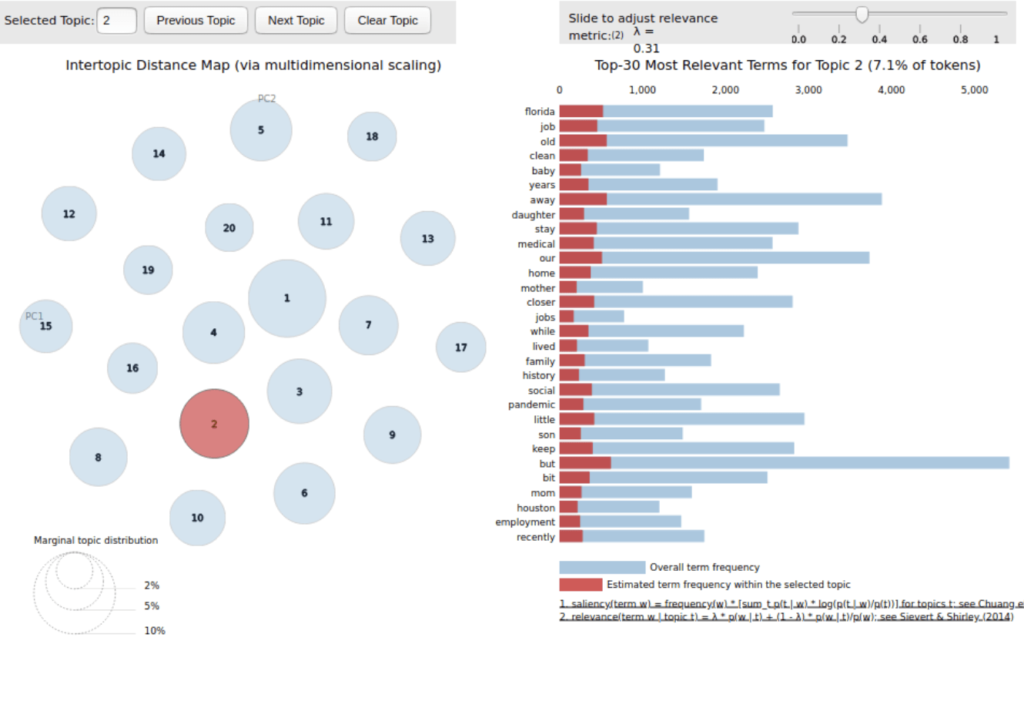AI for Good
How AI Assistants Can Help Fight Housing Discrimination
by James Chryssanthacopoulos, Data Scientist at Funnel
 As a data scientist, I’m passionate about taking complicated data and building models that can deliver insights and form the basis for new, innovative products. At Funnel Leasing, an industry-leading provider of software for the multifamily industry, I’m helping to build a new virtual leasing assistant, or AI assistant, that assists prospective renters in finding their next home. By answering renters’ questions faster or booking their viewings sooner, the AI assistant can deliver a lot of value to renters and management companies, but developing it presents its own unique challenges. The biggest challenge relates to the fact that, as we’re all aware, there are many ways people can ask questions or inquire for more information. For this reason, instead of handcrafting logic to account for the many ways messages can be phrased, modern approaches rely on machine learning, which builds a model automatically from data. For the AI assistant, the data consists of a collection of renters’ messages, which are annotated by hand to indicate their intent and other valuable information. From there, an algorithm optimizes a model that relates messages to the information they contain, so that when a new message arrives, the intent behind it can be inferred. Using the model, the AI assistant is able to respond successfully to some of the most common inquiries renters make, freeing human team members to perform more complex tasks.
As a data scientist, I’m passionate about taking complicated data and building models that can deliver insights and form the basis for new, innovative products. At Funnel Leasing, an industry-leading provider of software for the multifamily industry, I’m helping to build a new virtual leasing assistant, or AI assistant, that assists prospective renters in finding their next home. By answering renters’ questions faster or booking their viewings sooner, the AI assistant can deliver a lot of value to renters and management companies, but developing it presents its own unique challenges. The biggest challenge relates to the fact that, as we’re all aware, there are many ways people can ask questions or inquire for more information. For this reason, instead of handcrafting logic to account for the many ways messages can be phrased, modern approaches rely on machine learning, which builds a model automatically from data. For the AI assistant, the data consists of a collection of renters’ messages, which are annotated by hand to indicate their intent and other valuable information. From there, an algorithm optimizes a model that relates messages to the information they contain, so that when a new message arrives, the intent behind it can be inferred. Using the model, the AI assistant is able to respond successfully to some of the most common inquiries renters make, freeing human team members to perform more complex tasks.
At this point, it’s tempting to conclude that, because machine learning accepts data and uses math to generate the best model, the result is free from bias or human error. Yet with recent events drawing increased attention to racial inequality and discrimination prevalent in society, companies are taking greater steps to eliminate biases both within their organizations and in their products, and that includes AI-based products. In this spirit, Funnel Leasing is launching a new initiative, called H.O.M.E., to advance our commitment to provide underprivileged renters with access to safe and healthy housing. To start, H.O.M.E. has committed to donating a dollar for every online application completed on Funnel’s platform, but its larger goal is to combat systemic oppression present in the leasing process. In this blog post, I’ll focus on related efforts to address bias in the AI assistant. I’ll show that though machine learning utilizes the data it’s provided effectively, biases implicit in that data can make their way into the resulting model. Here’s a preview of some of the issues and how we tackled them that other organizations can learn from as they build out their AI systems with an eye toward fairness:
-
Foreign language recognition. When it comes to machine learning, it’s all about the data. If important messages to respond to aren’t present in the data used to build the model, the AI assistant won’t be able to respond to those messages. We found that to be the case for foreign language messages, which only constituted 0.6% of our data (561 in 100K messages). To address this, we built in foreign language detection, together with the ability to disable the AI assistant and hand off the conversation to human leasing team members to handle.
-
Affordable housing. We made sure to add support for inquiries about affordable housing, as well as least expensive apartments, by specifically annotating messages to identify when those intents are expressed in messages. Again, these kinds of messages only occur about 2% of the time in our dataset (see the figure below), but it’s important to be able to respond to them, especially given the economic uncertainties generated by the pandemic.
-
Other ways to address bias, like fairness metrics and topic modeling. There are many other ways of tackling bias that will be explored in the future, including establishing explicit fairness metrics, and using machine learning to automatically identify major topics on the minds of renters over time. Addressing bias in AI assistant related to the leasing process is never finished, but we hope that some of the efforts so far have gotten the conversation going about this important topic.
Funnel CRM and AI assistant overview
Funnel’s new AI assistant builds on the company’s decade-long success at delivering an intuitive, modern platform that enables leasing teams to manage prospective renters and guide them through the often stressful process of leasing a new home. This platform offers tools for leasing teams or specialized teams to call and email prospects, but it also provides some basic ways to respond to communications automatically, including an auto-response capability for first-touch messages and a chatbot that can be embedded into management companies’ websites. To further deliver on Funnel’s promise to provide an automated leasing experience, the AI assistant will facilitate longer conversations with prospects by email and text, supporting a greater range of inquiries and providing a seamless transition to a human team member when it can’t answer a question. See the screenshot below for an example of what a conversation with the AI assistant looks like within Funnel’s messaging platform.

Pitfalls with Machine Learning and How to Tackle Them
The AI assistant is designed to recognize the most common requests and inquiries prospective renters make, like scheduling a tour or inquiring about utilities. In this way, it’s expected to deliver significant benefit to management companies on day one. However, the most straightforward use of machine learning to build the AI assistant can introduce biases in terms of the kinds of messages, and therefore renters, the AI assistant recognizes and responds to. Before discussing these biases, I’ll briefly review how the AI assistant recognizes the various kinds of inquiries renters make.
There are many ways of extracting information from messages using machine learning, but broadly speaking, these methods are distinguished based on whether they require the messages to be annotated for specific content by hand first, or whether they only use the raw messages. Because the AI assistant is mainly intended to respond to the most common inquiries using specific information provided by management companies, it made sense to annotate the messages first to identify all instances of these inquiries and other valuable information. Below is a figure of the frequency of the inquiries representing some of the information gathered by the AI assistant.

Using the annotated messages, the machine learning algorithm optimizes a model that relates messages to their corresponding inquiries. The details vary on the exact algorithm used, but generally, successful algorithms learn patterns in the way different inquiries are phrased, while disregarding irrelevant details in the message.
As the predictions of the model ultimately reflect the data it was provided, if there are biases in the messages or in the way the annotators labeled them, those biases will make their way into the model. An example of this involving the AI assistant had to do with foreign language detection. The overwhelming majority of renter messages in our system are in English, but there are some messages written in other languages, most notably Spanish. Because these messages only constitute a small percentage overall, the model can’t learn the relationship between the foreign-language words and their corresponding content. Additionally, because annotators sourced by third-party annotation services likely don’t have the requisite knowledge to annotate these messages, foreign-language messages may get skipped and not included in the final annotated dataset. Hiring specialized annotators for different languages may be possible, but it’s difficult and can extend the data collection process. Again, even if it’s addressed, the messages still constitute a small percentage of the data, steering the model away from improving to recognize those examples. The resulting AI assistant may help most customers, but it’ll fail to service a specific, considerable part of the community. Though it might not be reflected in the final performance numbers, this is a major failing that needs to be addressed.
From a theoretical perspective, there are several ways to improve the model, like artificially inflating the proportion of foreign-language messages, but in light of the larger application in which the model is embedded, we landed on a different approach. The philosophy behind the AI assistant is that it should provide immediate feedback on inquiries it’s confident about, but disengage and hand the conversation over to a human team member when it’s not. That way, instead of taking a prospect down the wrong road and detracting from the experience, the AI assistant will make sure those clients get personalized service. This approach of handing over the conversation ensures the AI assistant provides relevant feedback while building the human team member’s confidence in the system. It also offers a natural way of addressing foreign-language and other specialized or difficult messages. By building foreign language detection into the AI assistant, we’ve enabled it to address those messages by escalating it up to the human team member through a handoff. See the screenshot below.

As you can see, when a foreign language is detected, the AI assistant is disabled, and the handoff reason is displayed to the human team member. Because the handoff reason is tracked throughout the application, team members can filter prospective renters by specific handoff reason. That way, if there’s a foreign-language speaker on the leasing team, that team member is able to provide those prospects with appropriate service.
In addition to foreign language detection, the AI assistant supports handing off the conversation for various other reasons. This includes instances in which frustration or profanity are detected, as well as those in which the team member doesn’t recognize any inquiries or relevant information at all. Many of these scenarios may not correspond to any recognizable bias, but the hope is that this handoff mechanism can cover many instances of messages with non-standard grammar or spelling that may not be well reflected in the training dataset.
However appropriate these measures are, they admittedly only represent ad-hoc additions to an AI assistant that uses data or processes that involve recognizable biases. Ultimately, a more principled approach would involve addressing these issues at the root source of the data, or in the training process itself. I’ll discuss one instance of this in the AI assistant, then provide more general ways biases can be addressed in the future.
Recall one of the goals of Funnel’s H.O.M.E. initiative is to provide underprivileged renters with access to good housing. Because the ability to execute on this requires good and timely service from the moment a prospective renter first reaches out, in many ways the H.O.M.E. initiative begins with the AI assistant. Because the training requires a dataset annotated for specific content, this meant making sure that the one of the categories provided to the annotators relates to affordable housing. While this inquiry also constitutes a relatively small percentage of messages (see the figure above), it’s important to capture these inquiries regardless of their overall frequency. The screenshot below shows how the assistant handles these messages. Additionally, since affordable housing usually refers only to subsidized housing, we’ve also added another category to address a general concern over finding the most affordable apartment. To inquiries like, “What are your cheapest one bedrooms?”, the assistant can provide the most relevant feedback, ordered by price. These kinds of inquiries are especially important to respond to given the uncertainty and hardship related to the pandemic.

By providing support for common messages from possible underprivileged renters and mechanisms for handing over to a human team member, the AI assistant tries to ensure all prospects get the service they deserve, but there are several ways of improving it. Again, the best way to address biases in the machine learning model is to de-bias the dataset by accurately annotating more messages it is biased against answering correctly. These messages include not only foreign-language messages and those about affordable housing, but all sorts of non-standard messages the assistant should be receptive to. In the absence of this careful process of annotation, the final proportions of underrepresented messages can be artificially increased before training, but in general, there’s no good substitute for assessing vulnerabilities in the dataset and re-annotating to address them. In the remainder of this blog, I’ll discuss two general tools that can be used in combination with that strategy to reduce bias in a conversational assistant.
Introduce Fairness Metrics
While we all possess an instinctive sense of what’s fair, it’s more difficult to distill it down into explicit criteria for what constitutes fairness that a computer can understand. Traditionally, machine learning algorithms optimize performance in terms of overall accuracy, or the number of false positives and negatives, but if they are to produce models that lead to fair treatment across different groups, it’s likely they’ll have to take into account other metrics that explicitly calculate fairness. What makes this difficult is that there isn’t a single definition of what constitutes fairness even within a given application. For the AI assistant, one way of assessing fairness might involve penalizing poor performance on messages from underrepresented groups, but which messages to penalize and to what extent is up for debate. The point is not to devise one authoritative definition of fairness for all time, but to bring war
eness to the issue, open up a debate about how to tackle it, and generate consensus about possible solutions. What if presentations of machine learning results included “fairness” as a metric alongside the more common, “F1” score? More importantly, what would that mean for future renters in terms of broadening housing access for all?
Discover What Renters Are Talking About
In many ways, the bias problem outlined above was actually introduced by the process of annotating messages with a given set of labels. As we’ve seen, annotators may fail to label certain classes of messages correctly, or the labels they’re provided may not reflect the most important categories from the standpoint of fairness. To address this, the second major approach to machine learning touched on above can be used. Recall in this approach, information is extracted from messages directly without requiring annotating them beforehand. Instead of mapping messages to labels, the algorithm groups together messages with similar content, allowing distinct topics to emerge directly from the data. Below is an example of 20 topics extracted from a collection of 100 thousand messages from prospective renters. The circles on the left indicate the topics, with sizes proportional to their frequency in the data. For the selected topic in red, the most common words contained in messages tagged as that topic are shown on the right. As you can see, this topic is dominated by occurrences of words like “job” and “employment,” as well as “pandemic,” “medical,” and “family.” The learned topics don’t always have obvious interpretations, but the appearances of these words are a strong indication that this topic relates to a general concern about the ability to provide for rent or engage in the leasing process during the pandemic.

While there may not be an appropriate way for the AI assistant to respond in all instances of a given topic, extracting information from messages directly shows us what the concerns of actual renters are. That kind of information will be important as the AI assistant matures and takes on more kinds of conversations. For example, the topics can be used directly by the AI assistant to provide the most relevant information, or they can be used to create a revised set of labels that annotators can use to more faithfully label messages. This hybrid approach of using results from both labeled and unlabeled data has the potential to improve overall performance, while expanding the range of support the AI assistant can provide. An AI assistant that knows about the concerns of real renters is better able to provide support for all renters.
I just touched on two methods that can help alleviate biases in machine learning models, but there are many other philosophies and tools for tackling this problem. For more information, or to further discuss these, please reach out to us.